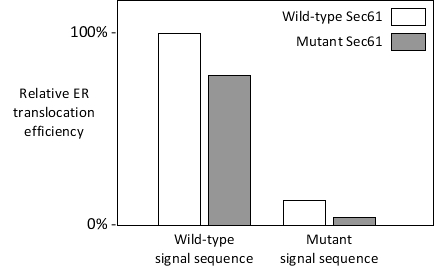The signal-recognition particle is not the only factor that evaluates the authenticity of endoplasmic reticulum (ER) signal sequences in proteins. The Sec61 complex is also able to recognize the signal sequences and "opens" after binding to them. Even single point mutations within the signal sequence of a protein can render the protein unable to enter the ER efficiently, as the Sec61 complex does not readily open in response to the mutant sequence. However, "suppressor" mutations in genes encoding components of the translocation pathway, including the Sec61 subunits, can partially restore the wild-type localization of proteins with mutant signal sequences. Many such suppressor mutations (also called prl mutations) map to or near the "plug" domain in the Sec61 translocon. These mutations, including the deletion of the entire plug, generally result in destabilization of the closed conformation of the translocon and favor its open conformation. Your friend has mutated a certain residue in the plug domain of the yeast Sec61. She has just finished measuring the translocation efficiency of an ER protein with either a wild-type or a mutant (defective) signal sequence, either in wild-type or in her Sec61-mutant cells, and has obtained the following results. Based on these early results, does her Sec61 mutation show a prl phenotype? Write down Yes or No as your answer.

Definitions:
PPACA
Patient Protection and Affordable Care Act, a significant healthcare reform law in the United States aiming to improve healthcare access, reduce costs, and enhance healthcare quality.
Employer Mandate
The requirement under the Patient Protection and Affordable Care Act (PPACA) of 2010 that firms with 50 or more employees pay for insurance policies for their employees or face a fine of $2,000 per employee per year. Firms with fewer than 50 employees are exempt.
PPACA
The Patient Protection and Affordable Care Act (PPACA), commonly known as Obamacare, is a United States federal statute enacted to increase health insurance quality and affordability, lower the uninsured rate by expanding public and private insurance coverage, and reduce the costs of healthcare for individuals and the government.
Personal Mandate
A requirement for individuals to purchase or otherwise obtain a particular good or service; often used in the context of compulsory health insurance.
Q10: In the following schematic diagram of a
Q12: The phosphofructokinase (PFK) enzyme is one of
Q12: Based on the results from the experiment,
Q14: A protein is covalently attached to glycosylphosphatidylinositol.
Q18: Two approaches have been devised to deal
Q24: Indicate whether each of the following descriptions
Q26: Many viruses have large capsids in the
Q32: What are the advantages of monoclonal antibodies
Q41: From an immortalized human HeLa cell line
Q54: The time courses of seeded actin polymerization